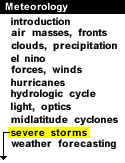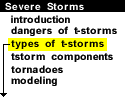
|
The array of thunderstorms within the spectrum reflects our current scientific understanding. Thus, while the spectrum is very useful, it is neither perfect nor a final solution. Nevertheless, arrangement of storms within the spectrum is dependent on updraft strength, here represented by different colors; relative frequencies of these updraft strength categories, as indicated by differing lengths on the upper bar graph; and relative threats of the updraft categories, here represented by the lengths on the bottom bar graph.
 |
Thus, while a "strong" updraft is less common than a "weak" updraft, the relative threat to life and property is greater with the "strong" updraft storm. Similarly, "intense" updraft storms are quite rare but inflict a disproportionate amount of damage and personal injury. |
The breakdown into single cell, multicell, and supercell covers the major storm types within the spectrum. One "cell" denotes one updraft/downdraft couplet. Thus, there are several updrafts and downdrafts in close proximity with a multicell storm. Multicell storms can be broken down further into the categories of multicell line and multicell cluster storms. The "intense" updraft storm is almost invariably the supercell, a storm capable of producing the most devastating weather, including violent tornadoes.
 |
With the two multicell storm categories, we have defined four basic storm types from the thunderstorm spectrum. The supercell is always severe, whereas the others can be non-severe or severe. We stress that a "severe" storm is a somewhat arbitrary National Weather Service definition of a storm with one or more of the following elements: 3/4 inch or larger diameter hail, 50 KT downbursts, and tornadoes. |
Before reviewing these storms, it is important to emphasize that real thunderstorms do not always fit neatly into the categories we have just described. Research has suggested that the most basic distinction among storm types is between supercells and everything else, the so-called "ordinary" cells.
Non-supercell storms consist of one or more ordinary cells, and we have described three basic ways in which ordinary cells commonly occur: as isolated cells, as clusters of cells, and in lines of cells. Even though real storms can have physical traits that cross the boundaries of these categories, this classification scheme still has considerable value. This is because the intensity and type of weather events produced by a storm tends to be dependent on which category it fits most closely. We should also point out that a given storm may change its type one or more times during its existence.
| Types
Last Update: 7/23/97 |
Single Cell Storms
Typically last 20-30 minutes. Pulse storms can produce severe weather elements such as downbursts, hail, some heavy rainfall and occasionally weak tornadoes.
Multicell Cluster Storms
Multicell Line Storms
Supercells
|

Dangers of T-storms |
|

Single Cell Storms |




